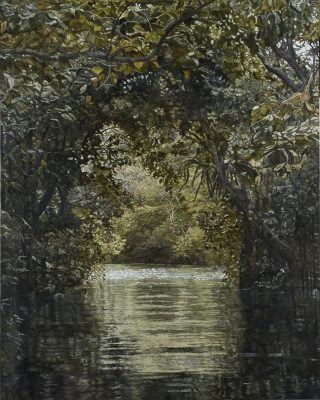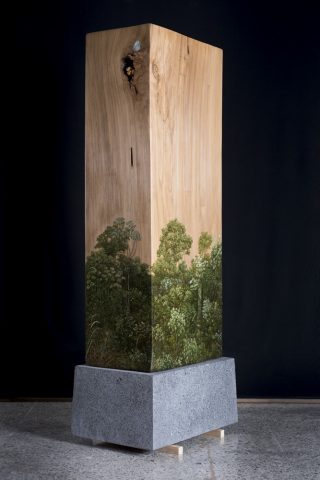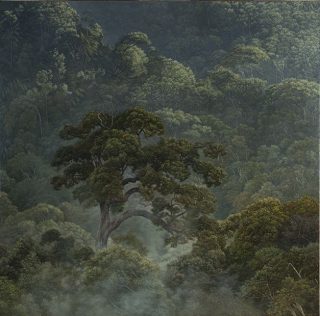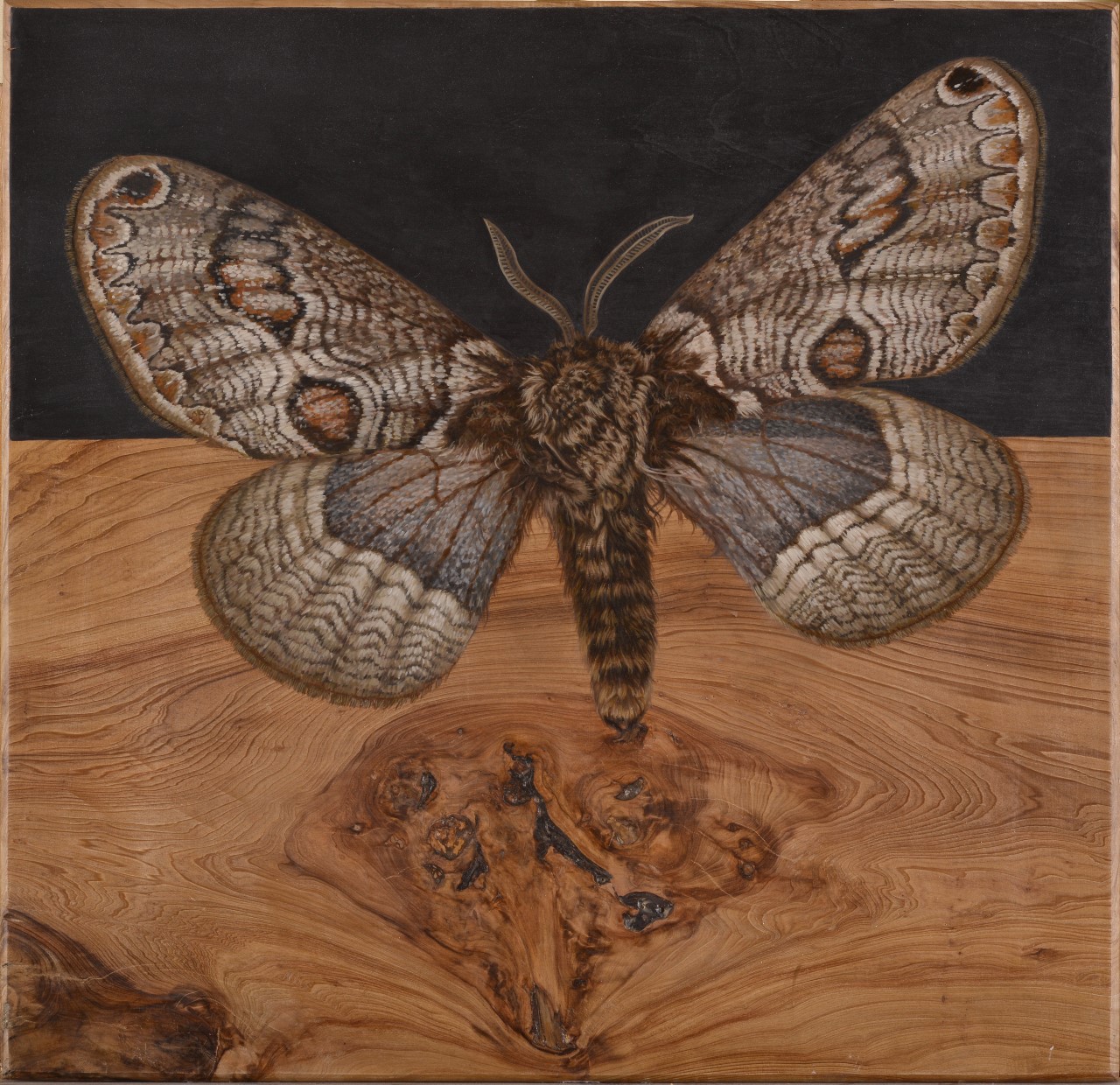Intervista a Maria Sada

When and how did your artistic career start?
I wanted to work or be around art since I was very young, about 14, and worked as an apprentice with a local artist when I was 17 years old, but I really didn’t know how to start, or what was I supposed to express…
I wasn’t very accomplished either… so I studied Art Conservation and worked in a professional studio for 30 years, restoring paintings and learning about styles and technics.
During that time I felt the need to paint and started doing it after work.
My first solo show was in 1998.
I was lucky to be contacted by a very good gallery in Mexico City in 1992, when I was 37 years old.
Which people, artists and episodes have most influenced your art?
First of all, I was influenced by the painter who I worked with.
He made me practice color theory using the impressionist palette.
Years later, while working on art conservation I tried to learn as much as I could from each painting I restored or saw at the studio.
I learned from a lot of painters, mainly Mexicans from the 1890-1950 period which we had more often in the studio, but also from Flemish artists, like Anton Van Dyck or Jacob van Ruisdael, or the wonderful Albrecht Dürer.
At the beginning I had the encouragement from my then husband, Manuel Serrano, who was my teacher and partner in the Art Conservation studio and also from a very experienced museum director, Fernando Gamboa, who visited me each week to see my work and talk about art.
I think my art conservation experience was the most important factor in the development of my work and, in the past 10 years, my full attention to my work.
What are you looking for through the art form you use?
I try to communicate the importance of natural lands and its inhabitants, trying to represent the feelings and thoughts that I have in relation to the enormous beauty they possess and, at the same time, their fragility.
Is there a part in your artistic research that you would like to talk about in particular?
The more you know about the materials you are working with, and the more art you can study in museums and books the more possibilities, or repertoire of technics, you can use as tools to express yourself.
That’s what I have tried to do in relation to my craft.
Concerning the subject matter, I’ve researched biosphere and its fragility in present times to convey our responsibility for its impending demise.
What is your relationship with the art market?
I show and sell my work through an important mexican gallery, Galería de Arte Mexicano, GAM.
I produce 6 to 8 paintings a year, so I cannot keep the pace of production you need in order to be inside the international art market of today…
What would you recommend to an artist who would like to live on art?
That’s a hard question… I believe that the making is more important than the selling… and experience has made me understand that the life of a painter is a hard one economically speaking, so I would recommend, first: be honest with you and paint or do what you really believe is important, even if it doesn’t pay your expenses… maybe doing another kind of work in parallel.
If you really want to be well known and compete in the art market of today, I think is very important to have connections to people that are already inside and can help you.
Some people enter to every competition, biennials, apply to grants and other venues.
web page: https://mariasada.com/2017/
facebook: https://www.facebook.com/maria.sada1

Traduzione:
Quando e come è iniziata la tua carriera artistica?
Volevo lavorare o dedicarmi all’arte fin da quando ero molto giovane, a circa 14 anni, ho lavorato come apprendista con un artista locale quando ne avevo 17 anni, ma non sapevo davvero come iniziare, o cosa avrei dovuto esprimere…
Non ero neanche molto brava, quindi ho studiato Art Conservation e ho lavorato in uno studio professionale per 30 anni, restaurando dipinti e conoscendo stili e tecniche.
Durante quel periodo ho sentito il bisogno di dipingere e ho iniziato a farlo dopo il lavoro.
La mia prima mostra personale è stata nel 1998.
Sono stata fortunata ad essere contattata da una galleria molto buona a Città del Messico nel 1992, quando avevo 37 anni.
Quali persone, artisti ed episodi hanno influenzato maggiormente la tua arte?
Prima di tutto, sono stata influenzata dal pittore con cui ho lavorato.
Mi ha fatto praticare la teoria del colore usando la tavolozza impressionista.
Anni dopo, mentre lavoravo alla conservazione dell’arte, ho cercato di imparare il più possibile da ogni dipinto che ho restaurato o che ho visto in studio.
Ho imparato da molti pittori, principalmente messicani del periodo 1890-1950, che avevamo più spesso in studio, ma anche da artisti fiamminghi, come Anton Van Dyck o Jacob van Ruisdael, o il meraviglioso Albrecht Dürer.
All’inizio ho avuto l’incoraggiamento del mio ex marito, Manuel Serrano, che era il mio insegnante e partner nello studio di conservazione dell’arte e anche da un direttore di museo molto esperto, Fernando Gamboa, che mi visitava ogni settimana per vedere il mio lavoro e parlare di arte.
Penso che la mia esperienza di conservazione dell’arte sia stata il fattore più importante nello sviluppo del mio lavoro e, negli ultimi 10 anni, la mia piena attenzione al mio lavoro.
Cosa stai cercando attraverso la forma d’arte che usi?
Cerco di comunicare l’importanza delle terre naturali e dei suoi abitanti, cercando di rappresentare i sentimenti e i pensieri che ho in relazione all’enorme bellezza che posseggono e, allo stesso tempo, alla loro fragilità.
C’è una parte nella tua ricerca artistica di cui vorresti parlare in particolare?
Più conosci i materiali con cui lavori e più arte puoi studiare nei musei e nei libri, più possibilità o repertorio di tecniche puoi usare come strumenti per esprimerti.
Questo è quello che ho cercato di fare in relazione al mio mestiere.
Per quanto riguarda l’argomento, ho studiato la biosfera e la sua fragilità nei tempi attuali per trasmettere la nostra responsabilità alla sua imminente morte.
Qual è il tuo rapporto con il mercato dell’arte?
Mostro e vendo il mio lavoro attraverso un’importante galleria messicana, Galería de Arte Mexicano, la GAM.
Produco da 6 a 8 dipinti all’anno, quindi non posso mantenere il ritmo di produzione di cui hai bisogno per essere all’interno del mercato internazionale dell’arte di oggi.
Cosa consiglieresti ad un artista che vorrebbe vivere d’arte?
È una domanda difficile… credo che la realizzazione sia più importante della vendita.
L’esperienza mi ha fatto capire che la vita di un pittore è difficile dal punto di vista economico, quindi consiglierei innanzitutto: sii onesto con te e dipingi o fai quello che ritieni veramente importante, anche se non ti paga le spese…
Magari facendo un altro tipo di lavoro in parallelo.
Se vuoi davvero essere ben noto e competere nel mercato dell’arte di oggi, penso che sia molto importante avere connessioni con persone che sono già dentro e possono aiutarti.
Alcune persone partecipano a qualsiasi competizione, biennale, si applicano a sovvenzioni e altri luoghi.

web page: https://mariasada.com/2017/
facebook: https://www.facebook.com/maria.sada1
Francesco Cogoni.



This interview has such clarity and honesty, as the work made by this remarkable artist.
Humility is rare these days, particularly in the world of creators. Thank you Angelo for this remarkable interview and window to Maria Sada’s mind.